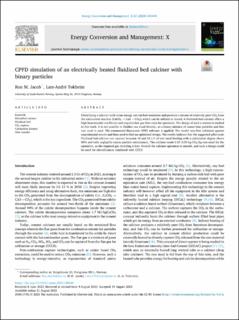| dc.contributor.author | Jacob, Ron Mangalam | |
| dc.contributor.author | Tokheim, Lars-Andre | |
| dc.date.accessioned | 2023-08-25T11:29:14Z | |
| dc.date.available | 2023-08-25T11:29:14Z | |
| dc.date.created | 2023-08-23T13:43:29Z | |
| dc.date.issued | 2023 | |
| dc.identifier.citation | Jacob, R. M. & Tokheim, L.-A. (2023). CPFD simulation of an electrically heated fluidized bed calciner with binary particles. Energy Conversion and Management: X, 20, Artikkel 100444. | en_US |
| dc.identifier.issn | 2590-1745 | |
| dc.identifier.uri | https://hdl.handle.net/11250/3085801 | |
| dc.description.abstract | Electrifying a calciner with clean energy can cut fuel emissions and produce a stream of relatively pure CO2 from the calcination reaction (CaCO3 → CaO + CO2), which can be utilized or stored. A fluidized bed calciner offers a high heat transfer coefficient and requires low gas flow rates for operation. The design of such a reactor is studied in this work. It is not possible to fluidize raw meal directly, so a binary mixture of coarse lime particles and fine raw meal is used. The commercial Barracuda CPFD software is applied. The model was first validated against experimental results and then used to find an optimized design. The results indicate that the suggested pilot-scale fluidized bed calciner can operate between 10 and 16 t/h of raw meal feeding with a calcination degree above 90% and with negligible coarse particle entrainment. The calciner needs 0.05–0.09 kg-CO2/kg-raw-meal for the operation, so the required gas recycling is low. Overall the calciner operation is smooth, and such a design could be used for electrification combined with CCUS. | en_US |
| dc.language.iso | eng | en_US |
| dc.rights | Navngivelse 4.0 Internasjonal | * |
| dc.rights.uri | http://creativecommons.org/licenses/by/4.0/deed.no | * |
| dc.title | CPFD simulation of an electrically heated fluidized bed calciner with binary particles | en_US |
| dc.type | Peer reviewed | en_US |
| dc.type | Journal article | en_US |
| dc.description.version | publishedVersion | en_US |
| dc.rights.holder | © 2023 The Author(s). | en_US |
| dc.source.volume | 20 | en_US |
| dc.source.journal | Energy Conversion and Management: X | en_US |
| dc.identifier.doi | https://doi.org/10.1016/j.ecmx.2023.100444 | |
| dc.identifier.cristin | 2169036 | |
| dc.relation.project | CLIMIT DEMO/Gassnova: 620035 | en_US |
| dc.source.articlenumber | 100444 | en_US |
| cristin.ispublished | true | |
| cristin.fulltext | original | |
| cristin.qualitycode | 1 | |

